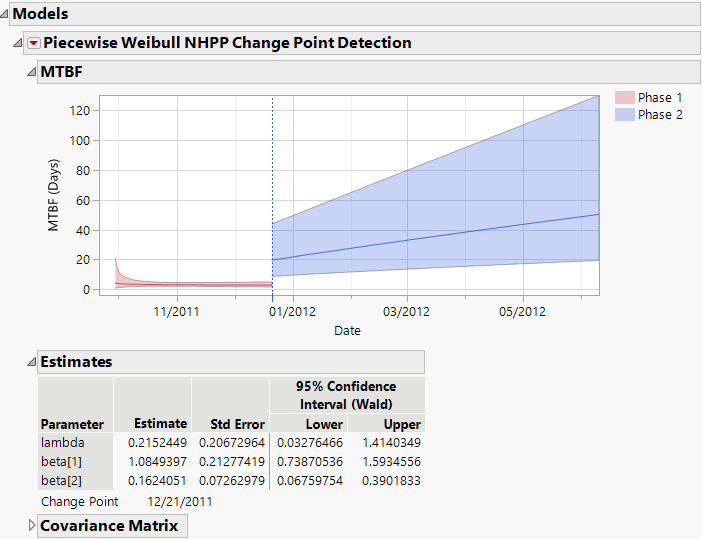Piecewise Weibull NHPP Change Point Detection
In the Reliability Growth platform, the Piecewise Weibull NHPP Change Point Detection option attempts to find a time point where the reliability model changes. This might be useful if you suspect that a change in reliability growth has occurred over the testing period. Note that detection seeks only a single change point, corresponding to two potential phases.
This option is available only when you have not entered a Phase variable in the launch window and one of the following is true:
• a single column has been entered as Time to Event or Timestamp in the launch window (indicating that failure times are exact), and
• two columns have been entered as Time to Event in the Concurrent Systems panel of the launch window.
When the Piecewise Weibull NHPP Change Point Detection option is selected, the estimated model plot and confidence bands are added to the Cumulative Events report under Observed Data. The Model List updates, giving statistics that are conditioned on the estimated change point. Under Models, a Piecewise Weibull NHPP Change Point Detection report is provided.
The default Piecewise Weibull NHPP Change Point Detection report shows the MTBF plot, Estimates, and Covariance Matrix. (See Figure 11.22, which uses the data in BrakeReliability.jmp, found in the Reliability subfolder.) Note that the Change Point, shown at the bottom of the Estimates report, is estimated as 12/21/2011. The standard errors and confidence intervals consider the change point to be known. The plot and the Estimates report are described in the section Piecewise Weibull NHPP.
Figure 11.22 Piecewise Weibull NHPP Change Point Detection Report
Available options are: Show MTBF Plot, Show Intensity Plot, Show Cumulative Events Plot, Show Profilers. These options are described in the section Reinitialized Weibull NHPP Options.
The procedure used in estimating the change point is described in Statistical Details for the Piecewise Weibull NHPP Change Point Detection Report.
